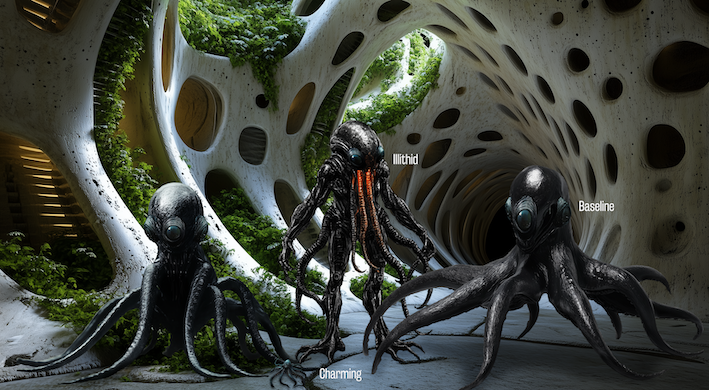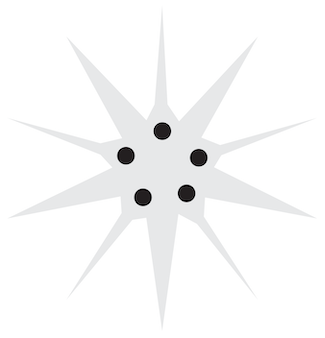Cephene
Cephenes are a race of squid-like aliens. However they are not squids or octupuses. In fact, they are not even molluscs.
There are two main challenges to drawing a cephene
- Cephenes are masters of genetic engineering and they not only come in millions of different forms, but they also often form colonies with each other. Some of their spaceships, for example, are bio-machine colonies of a few hundred cephenes.
- They are not adapted the earth-like conditions, so if they are in human environments, they will always be in their terraform suits.
The 3 Most Common Singleton Types of Cephene
In fact, even trying to come up with the three most common types is a challenge. However, we can say that the three most common singleton (as in non-colony) types in contact with humans are:
- the baseline cephene - a land-dwelling creature with ten tentacles and five eyes
- the aquatic cephene - a similar form, but are a retrovolve creature that is adapted to the cephene's prehistoric water-living past.
- the so-called illithid cephene - a neo-gen made to look vaguely human in shape.
These three types are pactured in their naked form below:

Now, these images are only approximate.
They are the best I could do with Mid Journey, because it just wanted to draw octopuses all the time.
Now we have the chance to actually visualise these things properly.
It's helpful to consider them naked for the moment, then we'll talk about their terraform suits or hysdrosuits.
Picturing a Cephene Without Their Terraform or Hydrosuits
Baseline Cephene
The baseline cephene is what the cephene evolved to before they became technological, and particularly, genetic engineering masters. If you look at them from above, you can see a distinct five-way symmetry:

You should be able to see two types of tentacles: a major tentacle for walking, with a minor tentacle on either side, for fine manipulation and handling. Both types of tentacle are split at the end, so that the cephene walks on pads, kind of like the way some jungle tree trunks have butresses. The minor tentacle's splits work like fingers. These are also split 5 ways, with all five "fingers" being equal (as in, they mutually oppose each other)
The black dots are where the eyes are, and each eye sits above a minor tentacle. This means that in each of the five directions, you have two eyes with two minor tentacles, and a major tentacle between them.
This arrangement is important, because it means that in any direction they travel, they have binocular vision, two minor tentacles, one leading major tentacle and 4 following major tentacles. This enables their movement skilled actions and detailed senses, no matter which direction they are going.
Baseline cephenes are dark grey as a basic colour, but they use body coloration as a means of communication, drawing symbols to each other. They do not have a voice like humans do.
They have a very thick skin. In the baseline version, this skin is fibrous, a bit like a rubber door mat. The bristles are very short, less than 5 mm, so cannot be seen from a distance.
In a certain light, you can see their vestigial rings that aquatic cephenes have (see next heading).
Aquatic Cephene
The aquatic cephene is similar in appearance to the baseline except their skins are much smoother. The bristles are much smaller, but they have rings all over their bodies, a little like the suction cups on octopuses, but in the case of cephenes, they are much flatter, barely rising above the rest of the surface.
Illithid Cephene
There is a cultural movment amongst the cephenes that has had a segment of the population favour assimilation with human and freen cultures. This has resulted in a few variations of the so-called illithid cephene. This is an attempt by cephenes to have a bipedal, bilateral symmetric body, remembling that of a human. They still have no skeletal structure, but they have lost the five-way symmetry of their bretheren.
The Terraform Suit
A terraform suit is designed to be like a space suit for cephenes, but unlike the sort of space suit that you might be familiar with, these are designed to be worn all the time. A cephene will sleep in one, shower in one, essentially live in it all the time. The suit allows them to filter air for humans (or freens) into the form that they are used to as well as exist in the frigid temperatures that humans (and particularly freens) are used to. It intensifies their vision, so that they can see better in our dim conditions.
This means that a terraform suit is close-fitting, and seals the whole body from the hostile earth conditions. Both baseline cephenes and illithid cephenes use terraform suits.
These suits allow the display of their symbolic language over their bodies, as well as providing electomagnetic gripping in place of their butress pads (serving as their feet on the major tentacles).
The Hydrosuit
The hydro suit is similar, in principle, to the terraform suit, but allows an aquatic cephene to exist out of the water.